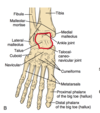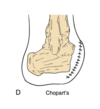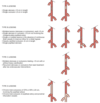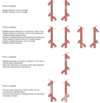Lower Extremity Flashcards
What is Leriche syndrome?
Triad: absent femoral pulses, intermittent claudication and impotence
Name 4 conditions that mimic PAD?
Spinal stenosis, OA, venous claudication, radiculopathy
What size would be an indication to repair a femoral aneurysm
Normal - 1 cm, indication for repair 3.5 cm (or 2.5 cm if intraluminal thrombus)
What conditions are associated with true femoral pseudoaneurysms?
- Old
- Male
- Smoking
- NTN
- Wegners granulamotosis
- Parkes-Weber
- Bechets
How do most femoral aneurysms present?
65% with claudication/CLI from embolic symptoms
What is the prefered conduit for interposition graft of femoral pseudoaneurysms?
Prosthetic - dacron or PTFE

Should you resect the aneurysm sac during femoral aneurysm repair?
Usually not - may injure surrounding structures
How can you obtain proximal control for large femoral aneurysms (2 ways)?
Proximal balloon occlusion from contralateral femoral.
Retroperitoneal exposure of suprainguinal external iliac artery
What are 3 contraindications to ultrasound guided compression?
Infection, ischemic skin changes, puncture above inguinal ligament,
What does thrombin do?
Converts fibrinogen to fibrin for direct clot formation. “Short circuits” coag cascade and therefore still works with heparin/warfarin on board
How much thrombin is usually required to induce thrombosis?
1000 units or 1 mL (comes in 1000 IU/mL)
What are 3 contraindications to bovine thrombin?
Allergy, infection, pregnancy
What are indications for an open surgical repair of femoral pseudoaneurysm?
- Contraindication to thrombin
- Failure of thrombin
- Skin ischemia
- AV fistulas
What is the embryologic origin of persistent sciatic artery?
Umbilical artery - should regress at 3 months gestational age
What percentage of popliteal aneurysms are bilateral?
50%
What percentage of popliteal aneurysm patients have an AAA?
30-50%
What percentage of AAA have coexisting popliteal aneurysms?
15%
What size threshold for repairing popliteal aneurysms?
> 3 cm or > 2 cm if ++ thrombus, symptomatic any size
What are 4 contraindications to endovascular popliteal aneurysm repair?
- Insufficient landing zone < 2cm proximal and distal
- Not able to take antiplt
- Gardner/carpenter/jobs with a lot of knee flexion
- Extremely tortuous
How long should patients be on dual antiplatelet after popliteal stenting?
4-6 weeks
How much should you oversize a popliteal viabhan for aneurysm repair?
10-15%
Which approach should you use to repair a large popliteal aneurysm that compresses adjacent nerves?
Posterior, unless very proximal
When should you treat an acutely ischemic limb secondary to popliteal aneurysm with thrombolysis?
Insufficient outflow vessels for bypass. Limb must be able to withstand 12-18h of ischemia
What is the objective criteria for Rutherford 0, category 0 CLI?
Normal treadmill or reactive hyperemia test
What is the objective criteria for Rutherford grade 0, category 1 CLI?
Completes treadmill exercise (5 min at 2mph at 12% incline), ankle pressure after exercise > 50 mm Hg
What is the objective criteria for Rutherford category 2 CLI?
Between categories 1 and 3
What is the objective criteria for Rutherford grade 1 category 3 CLI?
Cannot complete treadmill test, ankle pressure after exercise < 50 mm Hg
What is the objective criteria for Rutherford grade 2 category 4 CLI?
Resting ankle pressure < 40 mm Hg or barely pulsatile ankle or metatarsal PVR, toe pressure < 30 mm Hg
What is the objective criteria for Rutherford 3 category 5 CLI?
Resting ankle pressure < 60 mm Hg, ankle or metatarsal PVR flat or barely pulsatile, toe pressure < 40 mm Hg
What is the objective criteria for Rutherford grade 3, category 6 CLI?
Same as category 5 - resting ankle pressure < 60, toe pressure < 40, flat ankle/metatarsal PVR
What is the clinical description for Rutherford grade 3, category 6 CLI?
Major tissue loss extending above transmetatarsal, functional foot no longer salvageable
What is the clinical description for Rutherford grade 3, category 5 CLI?
Minor tissue loss, non healing ulcer/focal gangrene
What is the clinical description for Rutherford grade 2, category 4 CLI?
Ischemic rest pain
What is the clinical description for Rutherford grade 1, category 3 CLI?
Severe claudication
What is the clinical description for Rutherford grade 1, category 2 CLI?
Moderate claudication
What is the clinical description for Rutherford grade 1, category 1 CLI?
Mild claudication
What is the clinical description for Rutherford grade0, category 0 CLI?
Asymptomatic
What is the annual mortality rate of a diabetic with a foot ulcer?
10%
What is the 5 year mortality for diabetics who undergo a major amputation?
70%
What percentage of diabetic patients with a major amputation will require a contralateral limb amputation?
Up to 40%
How do diabetics develop equinis deformity?
Somatic neuropathy > muscle wasting > flexor extensor muscle imbalance > weakening of anterior calf muscle.
What are 2 effects sympathetic autonomic nerve dysfunction have on diabetic feet?
1 - Reduced sweating - dry fragile skin prone to fissuring
2-Microvascular AV shunt and impaired regulation of the skin, so foot may feel warm and well perfused and give false sense of security
What percentage of diabetic foot ulcers have contribution from arterial disease?
50%
What is PEDIS?
A way of describing diabetic foot ulcers: perfusion, extent, depth, infection and sensation.
What are important clinical signs of an acute Charcot foot?
Diabetic with unilateral hot swollen foot is Charcot foot until proven otherwise and requires offloading to prevent “rockerbottom” feet.
What does a Semms-Weinstein monofilament evaluate?
Sensation - to test diabetic patients risk of foot ulceration from neuropathy
What TBI is predictive of wound healing?
0.6 and above
What PVR amplitude threshold would indicate a wound was not likely to heal?
PVR < 5 mm
What PPG amplitude threshold would indicate a wound was not likely to heal?
< 50 mm Hg
What are 4 types of foot amputation?
1-transmetatarsal
2-Lisfranc (disarticulate the metarasals)
3 - Chopart (remove cuboids)
4 - Symes (whole foot)

What threshold tcPO2 is considered minimum for wound healing?
TcPO2 > 40 mm Hg for wound healing
What skin perfusion pressure (SPP) is predictive of healing
> 50 mm Hg
What is the intracompartmental pressure threshold for doing fasciotomies?
Absolute - 30 mm Hg - but not a good measure. Arterial pressure changes will alter compartmental pressure. MAP - ICP > 40 mm Hg dynamic pressure threshold may be more useful.
Why does ischemia reperfusion injury cause compartment syndrome?
oxygen radical generation increases microvascular permeability and efflux of plasma proteins with progressive interstitial edema
What are 6 risk factors for compartment syndrome due to ischemia reperfusion injury?
1 - ischemia > 6h
2 - young
3 - insufficient arterial collaterals
4 - poor backflow from embolectomy
5 - acute time course of occlusion
6 - hypotension
What is the risk of compartment syndrome if popliteal artery is injured in trauma?
High - 60%
What are 4 vascular causes for compartment syndrome?
1 - ischemia reperfusion injury
2 - venous outflow obstruction
3 - arterial/venous trauma
4 - hemorrhage
What are 4 non vascular causes for compartment syndrome?
1 - fracture (injured muscle causes bleeding in the compartment)
2 - iatrogenic (punctures in coagulopathic, dorsal lithotomy ORs, cast immobilization)
3 - crush injury
4 - “secondary” - SIRS + massive fluid resuscitation
What are 2 ways to measure compartment pressures?
Arterial line, stryker needle
What is a normal compartment pressure?
< 10 mm hg
Where should you test for numbness for an anterior compartment syndrome?
First dorsal webspace - deep peroneal distribution
Name 4 ways of blunting oxygen radical formation to reduce intracompartmental pressure
1-Mannitol
2- Allopurinol
3-thromboxane A2
4-melatonin
Only in animal models now
How does myoglobinuria lead to nephrotoxicity?
Vasoconstricts, renal tubular cast formation, direct heme protein induced cytotoxicity
How do you treat myoglobinuria?
Aggressive crystalloid infusion, forced diuresis with mannitol, alkalinazation of urine with bicarb (urine pH > 6.5)
Why do you use aggressive crystalloid and alkalinzation to treat myoglobinuria?
Heme proteins are not nephrotoxic in the abscence of hypovolemia and aciduria
Name 6 absolute indications for fasciotomy
1 - tense compartment with either 2 or 3
2 - pain on passive motion of muscles in the affected compartment
3 - paresis of muscles in the affected compartment
4 - tense compartment cannot be examined because obtunded patient
5- ICP - MAP < 40
6 - ICP - dBP < 10
What is the most common nerve injured during fasciotomy? Where does it course?
Superficial peroneal nerve. Descends along the septum separating anterior and lateral compartments
How long should fasciotomy skin incisions be?
15 - 20 cm
Where do you make the incisions for a 4 compartment fasciotomy?
Medial - 1-2 cm posterior to tibia, avoiding saphenous vein and nerve
Lateral - 4 cm from crest of tibia, 4/5 cm distal to fibular head to avoid injury to common, superficial and deep peroneal nerves

What is contained in the anterior compartment of the lower leg?
Muscle - tib ant, extensors (digitorum longus/hallicus longus)
Vessels - AT artery/veins
Nerve - deep peroneal

What is contained in the deep compartment of the lower leg?
Muscle - Tib post, Flexors (hallicus, digitorum), popliteus
Vessels - PT artery and veins
Nerve - Tibial

What is contained in the superficial compartment of the lower leg?
Muscle - Gastrocnemius, soleus, plantaris
Vessels - None
Nerve - None

What is contained in the lateral compartment of the lower leg?
Muscle - peroneus longus/brevis
Vessels - peroneal artery and veins
Nerve - superficial peroneal

Where do you make your incision for a “single - incision” 4 compartment fasciotomy?
Lateral incisoin over the fibula

What is contained in the anterior compartment of the thigh?
Muscle - quads (rectus femoris, vastus medialis, lateralis, intermedius), sartorius
Vessels: Femoral artery and vein
Nerve: Femoral nerve

What is contained in the medial compartment of the thigh?
Muscle - adductors (long, brev, mag, min), obturator, pectinius gracilis,
Vessels: Profunda artery and vein
Nerve: Obturator nerve

What is contained in the posterior compartment of the thigh?
Muscle - biceps femoris, semimembranosis, semitendonosis
Vessels: None
Nerve: Sciatic nerve

Where do you make your incision for a thigh compartment decompression?
Medial rarely needs decompression. Lateral incision at intertrochanteric line to lateral epicondyle

How do you open the medial compartment of the thigh?
Medial incision over adductor muscle group - rarely needed

How do you open the posterior compartment of the thigh?
Reflect vastus lateralis medially to expose lateral intermuscular septum

How do you open the anterior compartment of the thigh?
Cut through iliotibial band along length of incision (intertrochanteric line)

What are the compartments of the foot?
Variably described - medial lateral superficial calcaneal
Where do you make incisions for a foot fasciotomy?
2 plantar incisions - Medial to D2 and lateral to D4. Calcaneus requires separate incision for decompression
Must avoid medial and lateral plantar neurovasc bundles.
What are 5 ways of healing fasciotomy sites?
1 - secondary intention
2-delayed primary closure
3-split thickness skin graft
4 - myocutaneous flap
5-gradual dermal apposition
What is a Volkmann contracture?
Classic late consequence of missed compartment syndrome - ischemic muscle and nerves replaced with fibrotic tissue leaving compartment firm and dysfunctional
What is the diagnostic criteria for chronic
What is the diagnostic criteria for chronic exertional compartment syndrome?
Usually young athletes, reproducible, bilateral pain after 30 mins of exercise that abates with 30 mins of rest.
1) Resting ICP > 15
2) ICP > 30 after 1-2 mins of exercise
What is the treatment for chronic exertional compartment syndrome?
Avoid precipitating activities. Fasciotomy or fasciectomy (removal of an ellipse of fascia)

What percentage of amputations are due to diabetes?
25-90%
Are amputation rates increasing or decreasing over time?
Despite increase in diabetes, amputation rates are decreasing
Which patients are more likely to be offered primary amputation instead of revascularization?
regional variation, non-white, low income, no insurance
What is the overall mortality rate of major amputation?
8%














































































